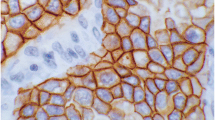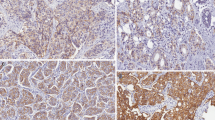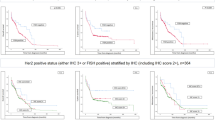Abstract
The role of HER-2/neu in male breast cancer is not well defined. The purpose of the current study was to measure the frequency of HER-2/neu expression in primary male breast cancer, to demonstrate HER-2/neu gene amplification in cases found to be positive for protein overexpression, and to correlate HER-2/neu positivity with clinicopathological variables. Formalin-fixed, paraffin-embedded archival material from 99 primary male breast carcinomas was evaluated by immunohistochemistry (IHC) using the HercepTest™ (DAKO Corp., Hamburg, Germany). Scoring was performed according to established guidelines. All cases demonstrating HER-2/neu staining by IHC (1+/2+ and 3+) were analyzed for HER-2/neu gene amplification by fluorescence in situ hybridization (FISH) utilizing the PathVysion™ assay (Vysis Corp., Downers Grove, Illinois) to assess HER-2/neu amplification status. The immunohistochemical staining of the HER-2/neu protein revealed HER-2/neu positivity in 15/99 (15.1%) cases, eight tumors showed 2+ and 7 tumors 3+ staining. HER-2/neu gene amplification was observed in 11/99 cases (11,1%), and all of the 3+ and 4/8 from the 2+ cases were amplified. HER-2/neu gene amplification/protein overexpression did not correlate with tumor state, histological grade or estrogen/progesterone receptor status nor the axillary lymph node status. This is the first comprehensive study of HER-2/neu gene amplification by FISH analysis in primary male breast cancer. Compared to female primary breast cancer the percentage of HER-2/neu positivity in our study was lower. Our data provide first evidence for HER-2/neu gene amplification in male breast cancer. Further studies should be addressed on the potential application of the monoclonal rhuMAB HER-2/neu antibody for treatment of HER-2/neu positive male breast cancer.
Similar content being viewed by others
References
Slamon DJ, Clark GM, Wong SG, Levin WJ, Ullrich A, McGuire WL: Human breast cancer: correlation of relapse and survival with amplification of the HER-2/neu oncogene. Science 235: 177–182, 1987
Slamon DJ, Godolphin W, Jones LA et al.: Studies of the HER-2/neu proto-oncogene in human breast and ovarian cancer. Science 244: 707–712, 1989
Khan AJ, King BL, Smith BD et al.: Characterization of the HER-2/neu oncogene by immunohistochemical and fluorescence in situ hybridization analysis in oral and oropharyngeal squamous cell carcinoma. Clin Cancer Res 8: 540–548, 2002
Press MF, Pike MC, Hung G et al.: Amplification and overexpression of HER-2/neu in carcinomas of the salivary gland: correlation with poor prognosis. Cancer Res 54: 5675–5682, 1994
Reese DM, Small EJ, Magrane G, Waldman FM, Chew K, Sudilovsky D: HER2 protein expression and gene amplifi-cation in androgen-independent prostate cancer. Am J Clin Pathol 116: 234–239, 2001
Cox G, Vyberg M, Melgaard B, Askaa J, Oster A, O'Byrne KJ: Herceptest: HER2 expression and gene amplification in non-small cell lung cancer. Int J Cancer 92: 480–483, 2001
Yamauchi H, Stearns V, Hayes DF: When is a tumor marker ready for prime time? A case study of c-erbB-2 as a predictive factor in breast cancer. J Clin Oncol 19: 2334–2356, 2001
Andrulis IL, Bull SB, Blackstein ME et al.: neu/erbB-2 amplification identifies a poor-prognosis group of women with node-negative breast cancer. Toronto Breast Cancer Study Group. J Clin Oncol 16: 1340–1349, 1998
Farabegoli F, Ceccarelli C, Santini D et al.: c-erbB-2 overexpression in amplified and non-amplified breast carcinoma samples. Int J Cancer 84: 273–277, 1999
Wright C, Angus B, Nicholson S et al.: Expression of c-erbB-2 oncoprotein: a prognostic indicator in human breast cancer. Cancer Res 49: 2087–2090, 1989
Pauletti G, Godolphin W, Press MF, Slamon DJ: Detection and quantitation of HER-2/neu gene amplification in human breast cancer archival material using fluorescence in situ hybridization. Oncogene 13: 63–72, 1996
Hudziak RM, Lewis GD, Winget M, Fendly BM, Shepard HM, Ullrich A: p185HER2 monoclonal antibody has antiproliferative effects in vitro and sensitizes human breast tumor cells to tumor necrosis factor. Mol Cell Biol 9: 1165–1172, 1989
Pietras RJ, Pegram MD, Finn RS, Maneval DA, Slamon DJ: Remission of human breast cancer xenografts on therapy with humanized monoclonal antibody to HER-2 receptor and DNAreactive drugs. Oncogene 17: 2235–2249, 1998
Pegram M, Hsu S, Lewis G et al.: Inhibitory effects of combinations of HER-2/neu antibody and chemotherapeutic agents used for treatment of human breast cancers. Oncogene 18: 2241–2251, 1999
Slamon DJ, Leyland-Jones B, Shak S et al.: Use of chemotherapy plus a monoclonal antibody against HER2 for metastatic breast cancer that overexpresses HER2. N Engl J Med 344: 783–792, 2001
Pauletti G, Dandekar S, Rong H et al.: Assessment of methods for tissue-based detection of the HER-2/neu alteration in human breast cancer: a direct comparison of fluorescence in situ hybridization and immunohistochemistry. J Clin Oncol 18: 3651–3664, 2000
Schnitt SJ: Breast cancer in the 21st century: neu opportunities and neu challenges. Mod Pathol 14: 213–218, 2001
Giordano SH, Buzdar AU, Hortobagyi GN: Breast cancer in men. Ann Intern Med 137: 678–687, 2002
Yildirim E, Berberoglu U: Male breast cancer: a 22-year experience. Eur J Surg Oncol 24: 548–552, 1998
Ravandi-Kashani F, Hayes TG: Male breast cancer: a review of the literature. Eur J Cancer 34: 1341–1347, 1998
Wang-Rodriguez J, Cross K, Gallagher S et al.: Male breast carcinoma: correlation of ER, PR, Ki-67, Her2-neu, and p53 with treatment and survival, a study of 65 cases. Mod Pathol 15: 853–861, 2002
Bloom KJ, Govil H, Gattuso P, Reddy V, Francescatti D: Status of HER-2 in male and female breast carcinoma. Am J Surg 182: 389–392, 2001
Joshi MG, Lee AK, Loda M et al.: Male breast carcinoma: an evaluation of prognostic factors contributing to a poorer outcome. Cancer 77: 490–498, 1996
Rudlowski C, Rath W, Becker AJ, Wiestler OD, Buttner R: Trastuzumab and breast cancer. N Engl J Med 345: 997–998, 2001
Sobin LH, Wittekind C (eds): TNM Classification of Malignant Tumours. John Wiley and Sons, Inc., New York, 1997
Elston CW, Ellis IO: Pathological prognostic factors in breast cancer. I. The value of histologcial grade in breast cancer: experience from a large study with lob-term follow-up. Histopathology 19(5): 403–410, 1993
Remmele W, Stegner HE: Vorschlag zur einheitlichen Definition eines Immunreaktiven Score (IRS) für den immunhistochemischen Östrogenrezeptor-Nachweis (ERICA) im Mammakarzinomgeweben. Pathologe 8: 138–140, 1987
Seshadri R, Firgaira FA, Horsfall DJ, McCaul K, Setlur V, Kitchen P: Clinical significance of HER-2/neu oncogene amplification in primary breast cancer The South Australian Breast Cancer Study Group. J Clin Oncol 11: 1936–1942, 1993
Rayson D, Erlichman C, Suman VJ et al.: Molecular markers in male breast carcinoma. Cancer 83: 1947–1955, 1998
Clark JL, Nguyen PL, Jaszcz WB, Jatoi A, Niehans GA: Prognostic variables in male breast cancer. Am Surg 66: 502–511, 2000
Bruce DM, Heys SD, Payne S, Miller ID, Eremin O: Male breast cancer: clinico-pathological features, immunocytochemical characteristics and prognosis. Eur J Surg Oncol 22: 42–46, 1996
Fox SB, Day CA, Rogers S: Lack of c-erbB-2 oncoprotein expression in male breast carcinoma. J Clin Pathol 44: 960–961, 1991
Jacobs TW, Gown AM, Yaziji H, Barnes MJ, Schnitt SJ: Comparison of fluorescence in situ hybridization and immunohistochemistry for the evaluation of HER-2/neu in breast cancer. J Clin Oncol 17: 1974–1982, 1999
Slamon DJ, Clark GM: Amplification of c-erbB-2 and aggressive human breast tumors? Science 240: 1795–1798, 1988
Wick MR, Sayadi H, Ritter JH, Hill DA, Reddy VB, Gattuso P: Low-stage carcinoma of the male breast. A histologic, immunohistochemical, and flow cytometric comparison with localized female breast carcinoma. Am J Clin Pathol 111: 59–69, 1999
Newman SP, Bates NP, Vernimmen D, Parker MG, Hurst HC: Cofactor competition between the ligand-bound oestrogen receptor and an intron 1 enhancer leads to oestrogen repression of erbB2 expression in breast cancer. Oncogene 19: 490–497, 2000
Bloom KJ, Govil H, Gattuso P, Reddy V, Francescatti D: Status of HER-2 in male and female breast carcinoma. Am J Surg 182: 389–392, 2001
Muir D, Kanthan R, Kanthan S: Male versus female breast cancers. A population-based comparative immunohistochemical analysis. Arch Pathol Lab Med 127: 36–41, 2003
Willsher PC, Leach IH, Ellis IO, Bourke JB, Blamey RW, Robertson JF: A comparison outcome of male breast cancer with female breast cancer. Am J Surg 173: 185–188, 1997
Joshi MG, Lee AK, Loda M et al.: Male breast carcinoma: an evaluation of prognostic factors contributing to a poorer outcome. Cancer 77: 490–498, 1996
Rayson D, Erlichman C, Suman VJ et al.: Molecular markers in male breast carcinoma. Cancer 83: 1947–1955, 1998
Wang-Rodriguez J, Cross K, Gallagher S et al.: Male breast carcinoma: correlation of ER, PR, Ki-67, HER2-neu, and p53 with treatment and survival, a study of 65 cases. Mod Pathol 15: 853–861, 2002
Pich A, Margaria E, Chiusa L: Oncogenes and male breast carcinoma: c-erbB-2 and p53 coexpression predicts a poor survival. J Clin Oncol 18: 2948–2956, 2000
Author information
Authors and Affiliations
Rights and permissions
About this article
Cite this article
Rudlowski, C., Friedrichs, N., Faridi, A. et al. Her-2/neu Gene Amplification and Protein Expression in Primary Male Breast Cancer. Breast Cancer Res Treat 84, 215–223 (2004). https://doi.org/10.1023/B:BREA.0000019953.92921.7e
Issue Date:
DOI: https://doi.org/10.1023/B:BREA.0000019953.92921.7e




